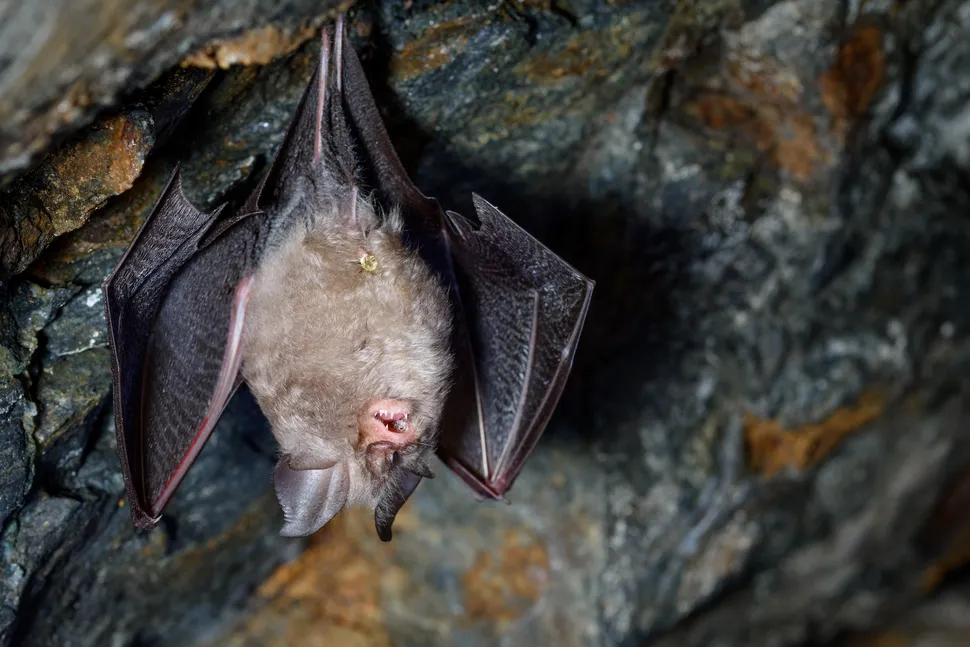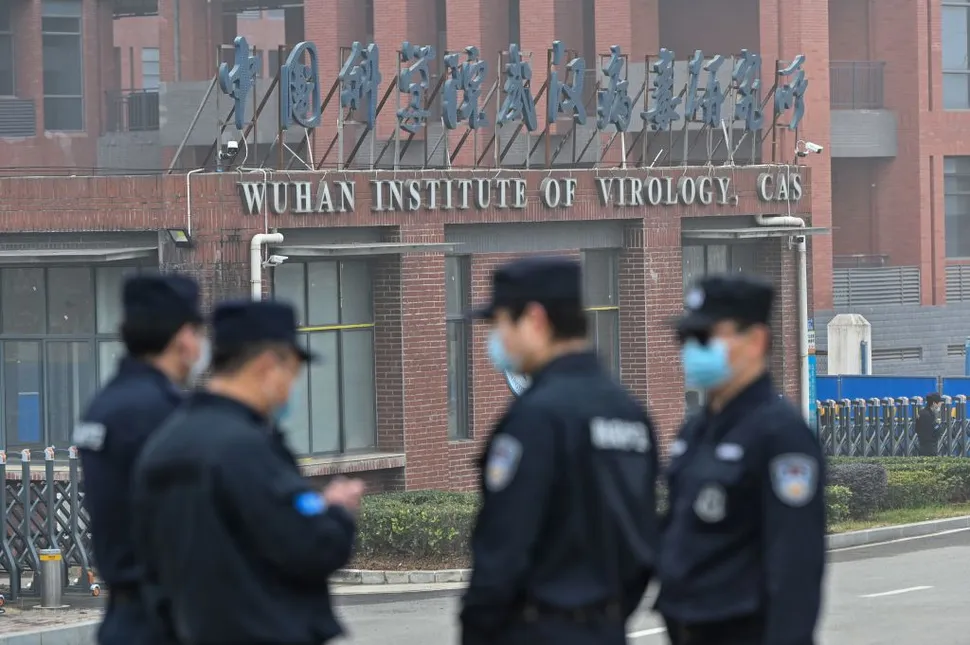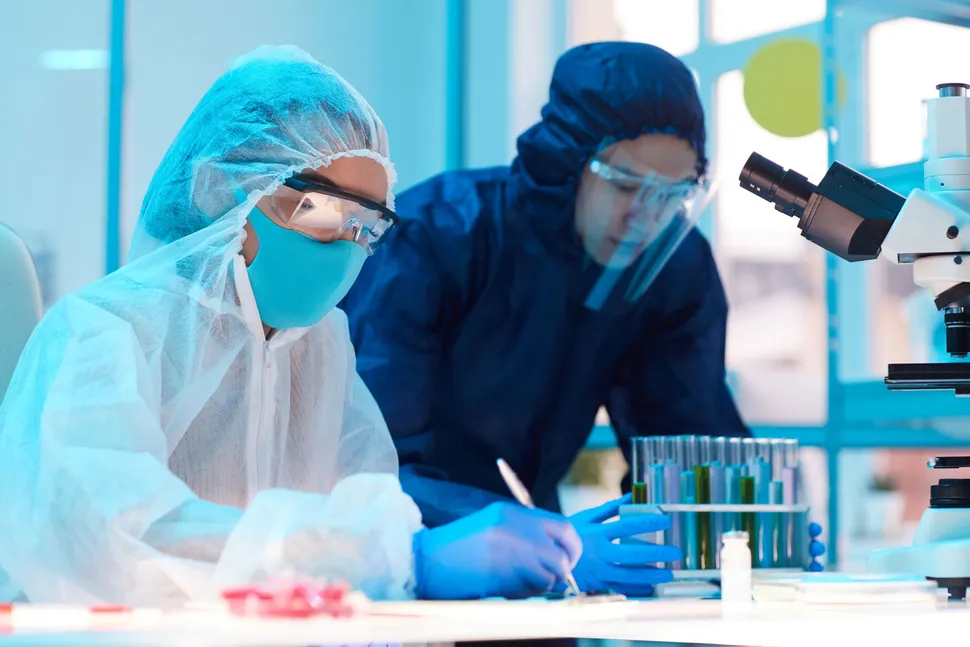새로운 코로나 바이러스의 기원에 대한 7가지 사실
By Rachael Rettner - Senior Writer about 18 hours ago
약 18시간 전 선임 작가 - 레이첼 레트너
The source of the virus has been hotly debated.
그 바이러스의 출처가 뜨겁게 논의되어 왔다.

A security guard stands outside the Huanan Seafood Wholesale Market where the coronavirus was first detected in Wuhan in January 2020. (Image credit: HECTOR RETAMAL/AFP via Getty Images)
2020년 1월 우한에서 코로나바이러스가 처음
발견된 화난해산물도매시장 밖에는 경비원이
서 있다
(이미지 크레딧: 게티이미지사를 통한 헥터
레타말/AFP)
Despite vast amounts of research on the novel coronavirus, known as SARS-CoV-2, little is known about its origins. Indeed, the source of the virus has been hotly debated, with some theories pointing toward a natural origin and others claiming the virus accidentally leaked from a lab.
SARS-CoV-2로 알려진 이 새로운 코로나
바이러스에 대한 방대한 연구에도 불구하고,
그 기원에 대해서는 알려진 바가 거의 없다.
사실, 바이러스의 출처가 뜨거운 논란에
휩싸여 있는데, 일부 학설들은 바이러스가
자연적 기원을 가리키고 있고 다른 학설들은
이 바이러스가 우연히 실험실에서 유출되었다
고 주장하고 있다.
Here's what we know about the origins of SARS-CoV-2.
우리가 알고 있는 사스-CoV-2의 기원은
다음과 같다.

Security guards stand in front of the closed Huanan Seafood Wholesale Market in the city of Wuhan, where some of the first cases of COVID-19 were reported, in January 2020. (Image credit: NOEL CELIS/AFP via Getty Images)
보안요원들은 2020년 1월 역간의 첫 번째 COVID-19
환자들이 발생한 우한시의 밀폐된 화난 해산물 도매
시장 앞에 서 있다. (이미지 크레딧: 게티 이미지사를
통한 NOEL CELIS/AFP)
In late December 2019, health officials issued the first warnings about a cluster of pneumonia cases in Wuhan, China. Those cases would turn out to be the world's first reported cases of COVID-19. By early January 2020, researchers had identified a novel coronavirus behind the cases, Live Science previously reported. Later, that virus would be officially named SARS-CoV-2.
2019년 12월 말, 보건당국은 중국 우한에서 발생한
한 무리의 폐렴 환자에 대한 첫 번째 경고를 발령했다.
이 사례들은 세계 최초로 보고된 COVID-19 사례로
밝혀질 것이다.
앞서 라이브 사이언스는 2020년 1월 초 연구진이
이 사건의 배후에 있는 새로운 코로나 바이러스를
발견했다고 보도했다.
나중에 그 바이러스는 공식적으로 SARS-CoV-2로
명명될 것이다.

A lesser horseshoe bat (Rhinolophus hipposideros). (Image credit: Shutterstock)
작은 관박쥐 (Rinolophus hipposideros)
(이미지 크레딧: 셔터스톡)
The closest known relative to SARS-CoV-2 is a coronavirus first identified in horseshoe bats in Yunnan province, China, in 2013, according to FactCheck.org. This virus, known as RaTG13, shares 96% of its genome with SARS-CoV-2. However, RaTG13 has certain genetic sequences that mean it could not have jumped directly from bats to people.
FactCheck.org에 따르면 SARS-CoV-2와 가장
가까운 것으로 알려진 것은 2013년 중국 윈난성
관박쥐에서 처음 확인된 코로나 바이러스다.
RaTG13으로 알려진 이 바이러스는 게놈의 96%
를 SARS-CoV-2와 공유한다.
그러나 RaTG13은 특정한 유전적 염기서열을
가지고 있어 박쥐에서 사람으로 직접 뛰어내릴
수 없었다.
And the viruses are different enough that researchers believe that SARS-CoV-2 is not its descendant.
그리고 그 바이러스는 연구원들이 SARS-CoV-2가
그 후손이 아니라고 믿을 만큼 충분히 다르다.
Rather, it's suspected that some unknown precursor to SARS-CoV-2 jumped into an intermediate host and that this host passed on the virus to people.
오히려, SARS-CoV-2의 어떤 알려지지 않은 전조가
중간 숙주에 뛰어들어 이 숙주가 사람들에게 바이러스를
전파한 것으로 의심되어진다.
This intermediate host has yet to be identified. A number of animals — including pangolins, dogs and even snakes — have been suggested as possible intermediate hosts, but none have been proven.
이 중간 호스트는 아직 식별되지 않았다. 판골린, 개,
심지어 뱀을 포함한 많은 동물들이 가능한 중간
숙주로 제안되었지만, 어떤 것도 증명되지 않았다.
It's also possible that there was not an intermediate host, and the virus jumped directly from bats to people, but to support this theory, researchers would need to find a virus in bats that's more closely related to SARS-CoV-2, according to FactCheck.org.
FactCheck.org에 따르면 중간 숙주가 없었고
바이러스가 박쥐에서 사람으로 바로 이동했을
가능성도 있지만, 이 이론을 뒷받침하기 위해서는
연구자들이 사스-CoV-2와 더 밀접한 관련이
있는 박쥐의 바이러스를 찾아야 할 것이라고
한다.
As part of an investigation into the origins of SARS-CoV-2 for the World Health Organization (WHO), researchers tested more than 80,000 samples from wildlife and farm animals — including bats, cattle and chickens — but did not detect SARS-CoV-2 in any of the samples, according to FactCheck.org. Some scientists have said that identifying an animal source for SARS-CoV-2 could take years.
세계보건기구(WHO)의 SARS-CoV-2의
기원에 대한 조사의 일환으로 연구원들은
박쥐, 소, 닭을 포함한 야생동물과 농장
동물에서 나온 8만 개 이상의 표본을
검사했지만 어떤 표본에서도 SARS-CoV-2를
발견하지 못했다고 FactCheck.org는 밝혔다.
일부 과학자들은 사스-CoV-2의 동물원을
확인하는 데 수년이 걸릴 수 있다고 말했다.

The Dancun Market, a wet market in Guangxi province, China, in September 2019. (Image credit: Qilai Shen/Bloomberg via Getty Images)
2019년 9월 중국 광시성 습식시장 단춘마켓
(이미지 크레딧: 게티 이미지사를
통한 Qilai Shen/Bloomberg)
Many of the first cases of COVID-19 were tied to the Huanan Seafood Market in Wuhan, and researchers initially suspected that this market was where the virus jumped from animals to people. But when researchers tested animal products sold at the market, none tested positive for SARS-CoV-2, Live Science previously reported. What's more, researchers later uncovered early cases of COVID-19 that were not tied to the market, as well as some cases that were tied to other markets. The WHO investigation results, released in March, concluded that no solid link between the Huanan market and the virus's origins could be made.
COVID-19의 첫 번째 사례는 우한의 화난
수산물 시장에 상당수가 묶여 있었고,
연구자들은 처음에 이 시장이 바이러스가
동물에서 사람으로 뛰어오른 곳이라고
의심했다.
그러나 연구진이 시장에서 판매되는 동물성
제품을 검사했을 때 SARS-CoV-2 양성반응은
나타나지 않았다고 라이브 사이언스는 예전에
보도했다.
더욱이 연구진은 나중에 다른 시장과 연계되지
않은 COVID-19의 초기 사례뿐만 아니라 다른
시장과 연계된 사례도 밝혀냈다.
지난 3월 발표된 세계보건기구(WHO) 조사 결과
화난시장과 바이러스의 기원 간에는 확실한
연관성이 없다고 결론 내렸다.
But other research suggests it's possible that the virus could still have originated at a market. A study published in June in the journal Scientific Reports surveyed markets in Wuhan that sold wild animals between 2017 and 2019, and found that there were more than 47,000 animals from 38 species sold at the markets during this time, according to The New York Times. Of these, 33 species are known to carry diseases that can also infect humans. In particular, the study found that minks, palm civets and raccoon dogs were sold at the markets, and these animals are known to harbor coronaviruses.
하지만 다른 연구에 따르면 바이러스는 여전히
시장에서 발생했을 가능성이 있다.
뉴욕타임스(NYT)에 따르면 지난 6월 학술지
사이언티픽리포트에 발표된 연구 결과 2017
~2019년 사이 우한에서 야생동물을 판매한
시장을 조사한 결과 38종 4만7000여 마리
이상이 판매됐다.
이 중 33종이 사람을 감염시킬 수 있는
질병을 옮기는 것으로 알려져 있다.
특히 밍크, 야자사향고양이, 너구리 등이
시장에서 판매되고 있는 것으로 나타났으며,
이들 동물은 코로나바이러스를 품고 있는
것으로 알려졌다.

Security personnel stand guard outside the Wuhan Institute of Virology. (Image credit: HECTOR RETAMAL/AFP via Getty Images)
우한 바이러스 연구소 밖에는 보안 요원들이
경비를 서고 있다.
(이미지 크레딧: 게티 이미지사를 통한 헥터
레타말/AFP)
Shortly after the COVID-19 pandemic began, many people noted that Wuhan is also the home of a prominent virology lab, known as the Wuhan Institute of Virology, where researchers studied coronaviruses, a family of viruses that also includes the viruses that cause severe acute respiratory syndrome (SARS) and Middle East respiratory syndrome (MERS).
COVID-19 대유행이 시작된 직후, 많은
사람들은 우한은 과학자들이 중증급성
호흡기증후군(SARS)과 중동호흡기
증후군(MERS)을 유발하는 바이러스
계열인 코로나바이러스를 연구한
우한 바이러스연구소로 알려진
저명한 바이러스학 연구소의
본거지이기도 하다는 점에
주목했다.
The lab was China's first "biosafety level 4" laboratory, meaning it met the criteria to handle the world's most dangerous pathogens, Live Science previously reported. One group at the lab, led by virologist Shi Zhengli, focused on coronaviruses and discovered the likely origins of the first SARS outbreak that occurred in 2003. The group also identified the RaTG13 virus. Some have wondered whether a researcher at the lab may have accidentally become infected with a coronavirus the team was studying. However, there's no hard evidence to support this theory. And although a lack of transparency has hindered the investigations, none of the coronavirus genetic sequences publicly released by the lab are closely related to SARS-CoV-2.
이 연구소는 세계에서 가장 위험한
병원균을 다루는 기준을 충족시켰다는
것을 의미하는 중국 최초의 "생물안전
4등급" 연구소였다고 라이브 사이언스는
앞서 보도했다.
시정리가 이끄는 이 연구소의 한 그룹은
코로나 바이러스에 초점을 맞추고
2003년에 발생한 최초의 사스 발병
원인을 발견했다.
이 그룹은 또한 RaTG13 바이러스를
확인했다.
일부는 연구소의 한 연구원이 연구팀이
연구하던 코로나 바이러스에 우연히
감염된 것이 아닌지 궁금해했다.
하지만 이 이론을 뒷받침할 확실한
증거는 없다.
투명성 부족이 수사를 방해하고 있지만
연구소가 공개한 코로나바이러스 유전자
서열은 사스-CoV-2와 밀접한 관련이 없다.

Yunnan province, China. (Image credit: Shutterstock)
중국 윈난성 (이미지 크레딧: 셔터스톡)
The March 2021 WHO report concluded that a spillover from wildlife through an intermediate host was the "likely to very likely pathway" for the original transmission of SARS-CoV-2 to humans. Many experts agree; after all, other recently emerged human coronaviruses, including the viruses that cause SARS and MERS, originated in animals.
2021년 3월 세계보건기구(WHO) 보고서는
중간 숙주를 통한 야생동물로부터의 유출이
인간에게 SARS-CoV-2의 원래 전파를 위한
"가능성이 매우 높은 경로"라고 결론지었다.
많은 전문가들이 동의하고 있다. 즉, 결국은
사스와 메르스를 일으키는 바이러스를 포함
하여 최근에 출현한 다른 인간 코로나 바이
러스들은 동물에서 비롯되었다는 것이다.
"While both lab and natural scenarios are possible, they are not equally likely — precedence, data and other evidence strongly favor natural emergence as a highly likely scientific theory for the emergence of SARS-CoV-2, while the lab leak remains a speculative hypothesis based on conjecture," Kistian Andersen, a professor of immunology and microbiology at The Scripps Research Institute in La Jolla, California, told the Times.
"실험실과 자연현상 모두 가능성은 낮지만
우선 순위, 데이터 및 다른 증거들은 SARS-
CoV-2의 출현에 대한 과학적 이론으로서
자연현상을 강하게 선호하고 있지만, 연구실의
유출은 추측에 근거한 추측 가설로 남아 있다"
고 캘리포니아 라 졸라에 있는 스크립스 연구소의
면역학과 미생물학 교수인 키스티안 안데르센은
타임즈에 말했다.

(Image credit: Shutterstock)
(이미지 크레딧: 셔터스톡)
However, other experts say a lab-leak theory is still a possibility that needs to be investigated. In May, more than a dozen researchers published a letter in the journal Science arguing that the lab-leak theory and the spillover theory "both remain viable," Live Science previously reported.
그러나 다른 전문가들은 실험실 유출설은 여전히
조사가 필요한 가능성이라고 말한다.
앞서 라이브 사이언스는 지난 5월 12명 이상의
연구자들이 사이언스지에 실험실 유출설과
(자연)유출설 모두 "실현가능하다"는 내용의 서한을
게재했다고 보도했다.
The letter notes that in the WHO report, "the two theories were not given balanced consideration" and that "there were no findings in clear support of either a natural spillover or a lab accident."
이 서한은 WHO 보고서에서 "두 이론이 균형
있게 고려되지 않았다"며 "자연 유출이나
실험실 사고에 대한 명확한 근거가 없었다"고
지적했다.

World Health Organization (WHO) Director-General Tedros Adhanom Ghebreyesus at the WHO headquarters in Geneva. (Image credit: FABRICE COFFRINI/POOL/AFP via Getty Images)
제네바 WHO 본부의 테오스 아하만 게헤브리우스 세계보건기구(WHO) 사무총장
(이미지 크레딧: 게티 이미지사를 통한 파브리스 코프리니/풀/AFP)
Many countries have also criticized the WHO report, which was conducted in partnership with Chinese scientists, for a lack of transparency and incomplete data, Live Science previously reported. Even WHO Director-General Tedros Adhanom Ghebreyesus has stated that the research team faced problems in accessing data in Wuhan, including data on early cases of COVID-19, according to CNN.
앞서 라이브사이언스는 "많은 국가들이 중국
과학자들과 손잡고 진행한 WHO 보고서는
투명성의 결핍과 불완전한 자료라고 비판해
왔다"고 보도했다.
테드로스 아드하놈 게브라이수스 WHO
사무총장조차 연구팀이 초창기 COVID-19사례
를 포함하여 우한의 데이터에 접근하는 데
문제가 있다고 밝혔다고 CNN은 전했다.
President Joe Biden has called for a renewed investigation into the issue, with a deadline of late August, according to a statement from the White House issued in May.
지난 5월 발표된 백악관의 성명에 따르면,
조 바이든 대통령은 8월 하순까지 이 문제에
대한 재조사를 요구했다.
Originally published on Live Science.
라이브 사이언스에 원본으로 발간됨.

댓글 없음:
댓글 쓰기